Discover Informative Blogs on Healthcare Solutions
Search by Blog
Read by Category
Patient Care Solutions
Health & Wellness
Environmental Health
First Aid & Emergency Care
Advance Wound Care
Wound Care
Your healing journey continues beyond this blog
Find the right products for better recovery at online store

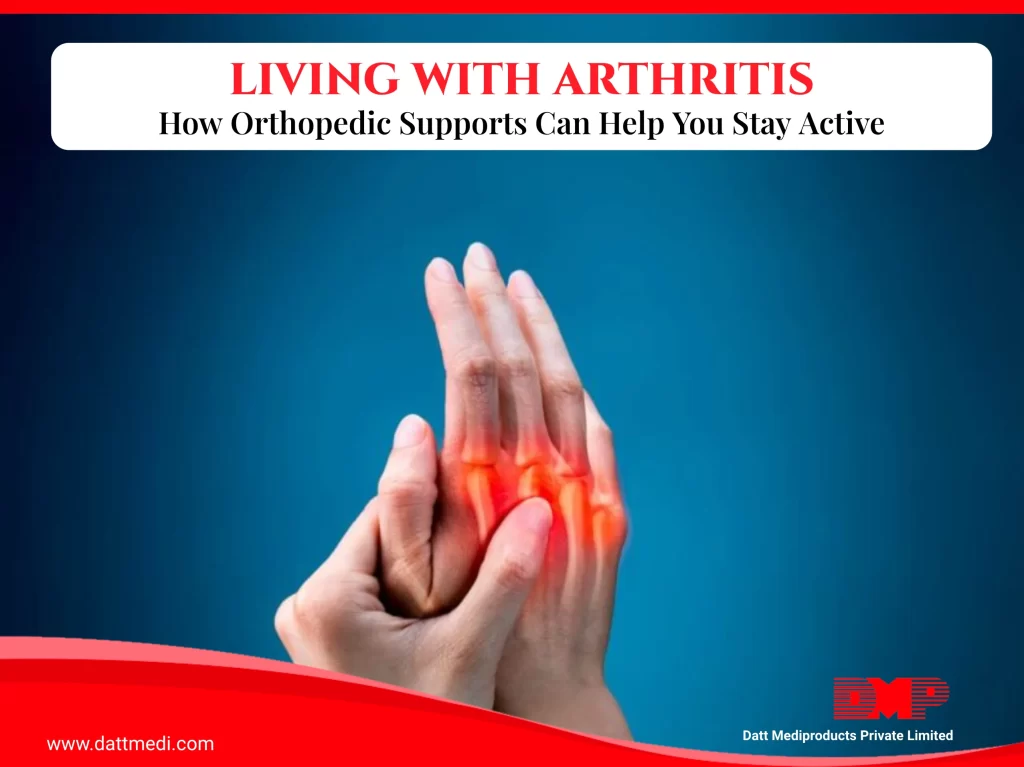
Arthritis is one of the most common chronic conditions affecting joints, with millions worldwide experiencing its impact daily. Characterized by joint pain, stiffness, and swelling, arthritis can significantly reduce mobility and quality of life.
While medical treatments and therapies are essential, patients often seek supportive solutions that offer daily relief and improve comfort.
Challenges Faced by Arthritis Patients
Living with arthritis is more than dealing with occasional discomfort—it involves:
- Persistent joint pain and stiffness, limiting day-to-day movement.
- Swelling and inflammation, which can worsen with activity.
- Reduced grip and mobility, affecting simple tasks like walking, lifting, or writing.
- Emotional impact, as long-term discomfort can lead to frustration, anxiety, and reduced independence.
These challenges highlight the importance of accessible, non-invasive support solutions.
How Orthopedic Support Products Help
Orthopedic aids like compression sleeves, joint supports, and braces are designed to complement medical management of arthritis. They provide:
- Gentle compression, improving circulation and reducing swelling resulting in a quicker recovery.
- Targeted support, stabilizing affected joints and limiting excessive strain.
- Improved comfort, easing pressure during movement or rest.
By addressing both pain and mobility limitations, these products serve as practical companions in daily arthritis care.
Benefits of Using Orthopedic Supports for Arthritis
Patients using compression sleeves and joint supports may experience:
- Pain reduction through controlled pressure and warmth.
- Decreased inflammation by enhancing blood flow and minimizing fluid buildup and an enhanced lymphatic drainage to flush out toxins.
- Better joint alignment and stabilisation reducing the risk of further strain or injury allowing the muscles and joints to function effectively.
- Enhanced confidence and mobility, allowing greater participation in daily activities.
Choosing the Right Product
Selecting the appropriate orthopedic support is essential for effectiveness:
- Compression sleeves: Best for continuous wear, mild-to-moderate pain, and swelling reduction.
- Knee or elbow supports: Ideal for stabilizing specific joints during activity and to redistribute your weight thereby reducing knee pain.
- Braces with adjustable straps: Suitable for patients requiring targeted support or customized pressure.
- Medical consultation: Always recommended to ensure the chosen product meets the patient’s condition and needs.
To maximize benefits, orthopedic supports should be incorporated into everyday routines:
- Wear during physical activity or prolonged standing to prevent flare-ups.
- Combine with gentle exercises recommended by physiotherapists.
- Use alongside healthy lifestyle practices, including weight management, balanced nutrition, and anti-inflammatory habits.
- Regularly monitor product fit and condition to maintain comfort and effectiveness.
Arthritis may be a lifelong condition, but it does not have to define a patient’s independence or comfort. Orthopedic products like compression sleeves and joint supports provide accessible, non-invasive relief—helping reduce pain, control inflammation, and support mobility.
By choosing the right product and integrating it into daily life, patients can regain confidence, ease, and a better quality of life.
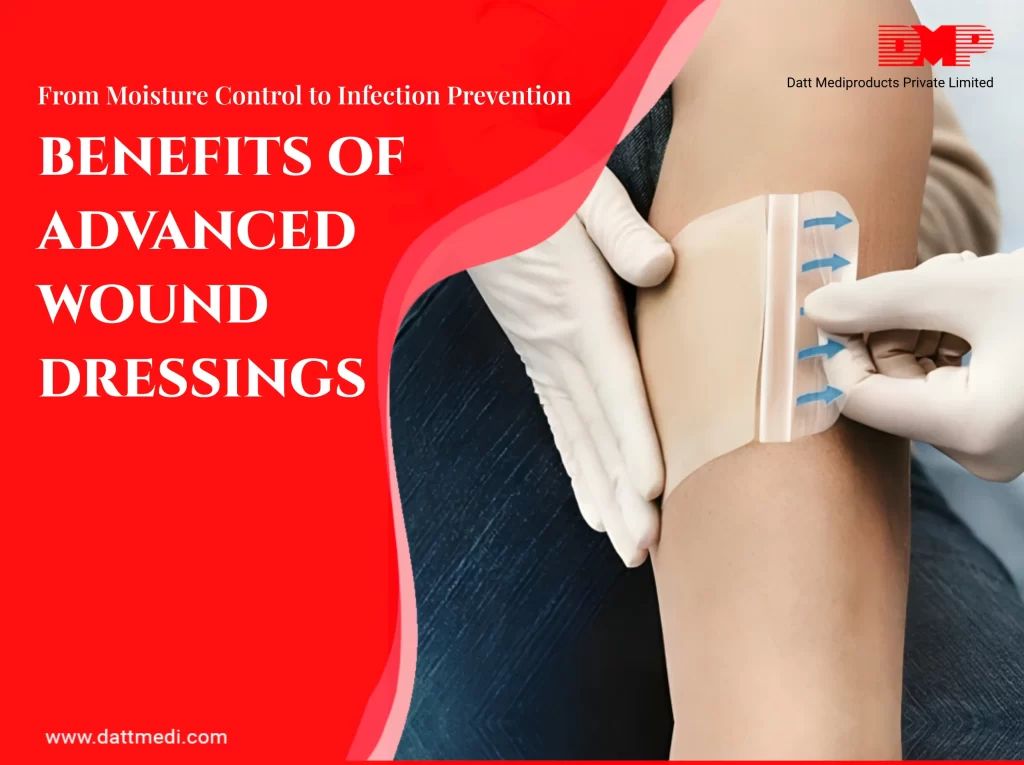
Traditional wound dressings were once viewed as simple barriers to shield an injury from external contaminants. Today, advanced wound dressings are revolutionizing wound care. They are active healing tools—designed not only to protect but also to accelerate recovery, reduce complications, and enhance patient comfort.
By responding to the needs of each wound, they support faster, more effective healing compared to conventional methods.
Beyond Basic Dressings: Creating a Bioactive Healing Environment
Unlike basic gauze pads, some advanced dressings provide a controlled, bioactive environment that stimulates wound repair. By incorporating various bioactive molecules such as antimicrobials. They:
- Maintain optimal moisture balance.
- Promote the healing process
- Regulate oxygen exchange.
- Some dressings offer antimicrobial protection when needed.
This environment allows cells to regenerate more efficiently, reduces infection risk, and shortens healing time.
Why Advanced Wound Dressings Are Essential for Complex & Chronic Wounds
Complex wounds such as diabetic ulcers, burns, and pressure sores often fail to heal with standard dressings. Advanced wound care solutions are essential because they:
- Restart stalled healing by balancing moisture and oxygen.
- Manage high exudate levels through superior absorption.
- Lower infection risks with antimicrobial properties.
These features make them indispensable for patients facing prolonged recovery.
Key Benefits of Advanced Wound Dressings
Using advanced dressings offers multiple clinical and patient-centered advantages:
- Moisture regulation – prevents drying and maceration.
- Reduced pain – cushioning and non-stick materials minimize discomfort during changes.
- Better comfort – lightweight, breathable materials allow mobility.
- Faster wound closure – optimized healing conditions accelerate recovery.
When to Choose Advanced Wound Dressings
Healthcare professionals should consider advanced dressings when:
- Healing has been delayed or stalled.
- The wound produces excessive drainage or exudate.
- There is a high risk of infection.
- Surgical incisions require enhanced healing protection.
In these cases, basic dressings often fail or take too long to heal the wound, while advanced dressings deliver targeted support.
Wounds That Benefit Most from Advanced Dressings
Certain conditions see the greatest benefit from these solutions:
- Diabetic ulcers – require moisture retention and infection control.
- Pressure sores (bedsores) – need pressure relief and high absorption.
- Surgical wounds – advanced dressings reduce infection risk and improve scarring.
- Burn injuries – delicate tissue heals faster with protective, moist dressings.
How to Choose the Right Advanced Wound Dressing
Selecting the correct dressing depends on the wound’s characteristics:
- Moist wounds → use absorbent foam or alginate dressings.
- Dry wounds → apply hydrogel dressings for hydration.
- Infected wounds → use antimicrobial dressings.
- Deep wounds → choose layered or cavity-fill dressings such as negative pressure therapy.
Matching dressing type to wound condition ensures maximum healing efficiency.
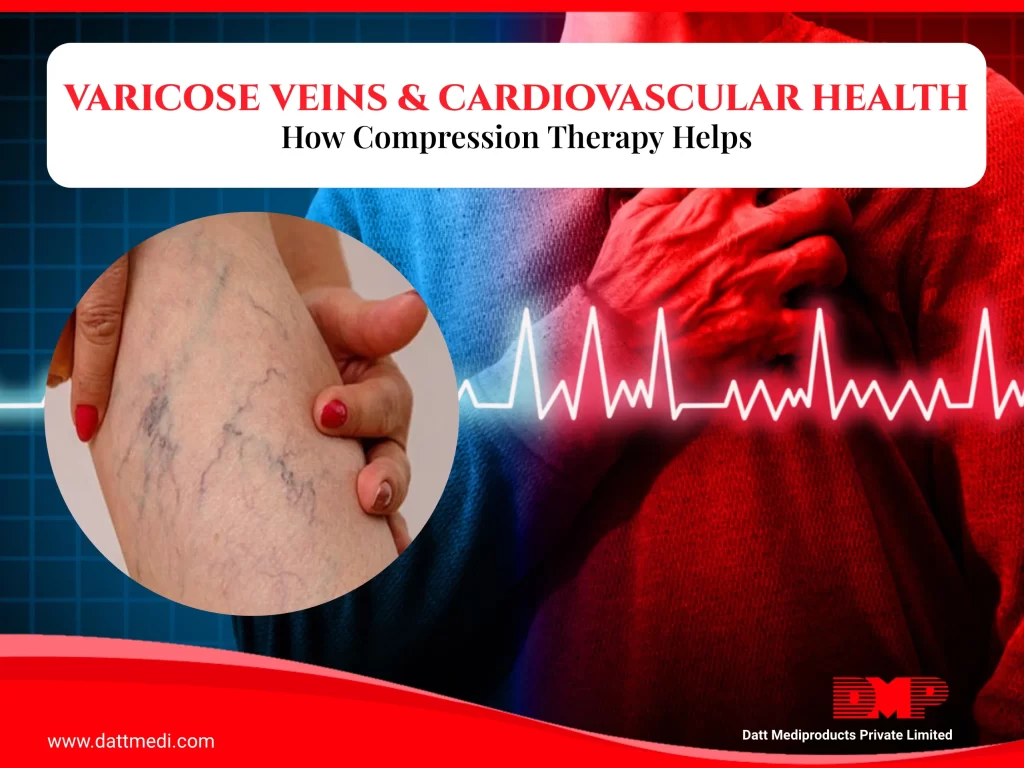
World Heart Day, observed annually on September 29, focuses on promoting cardiovascular health worldwide. An essential but often overlooked aspect of cardiovascular wellness is venous health, which plays a critical role in overall circulation and mobility.
Compression therapy has emerged as a cornerstone in managing venous insufficiency and related disorders, offering effective support for improved circulation and symptom relief.
Understanding Venous Insufficiency and Varicose Veins
1. Venous Insufficiency:
This condition arises when the veins, especially in the lower limbs, fail to efficiently return blood to the heart. It results in blood pooling, leading to symptoms such as leg swelling, heaviness, pain, and fatigue. Normally one-way valves or muscles pump blood back to the hear, but in venous insufficiency the valves are weakened or damaged causing blood to flow backwards or pool in the legs.
2. Varicose Veins:
This is one of the by products of venous insufficiency. Caused by weakened vein walls and malfunctioning valves, varicose veins are dilated, twisted veins visible under the skin surface. These can cause discomfort, skin changes, and increase the risk of ulcers if left unmanaged.
Role of Compression Therapy in Venous Health
Compression therapy applies controlled, graduated pressure to the legs, enhancing venous return by supporting vein walls and valves. This mechanical assistance:
- Improves blood flow velocity
- Reduces venous pressure and pooling
- Minimizes edema (swelling) and associated discomfort and pain
- Improves microcirculation in tiny blood vessels which is crucial for tissue oxygenation and healing
Benefits of Compression Therapy for Cardiovascular Health
- Enhanced Circulation: Promotes efficient blood return to the heart, thereby reducing risks of deep vein thrombosis (DVT) and venous stasis.
- Symptom Management: Compression alleviates pain, swelling, and skin changes, improving patient mobility and quality of life.
- Post-Surgical Recovery: Compression therapy accelerates healing after vein surgery or injury by controlling inflammation and supporting tissue repair.
Scientific Backing and Clinical Guidelines
Multiple clinical studies and guidelines from vascular health authorities endorse the use of compression therapy as a first-line, evidence-based treatment for venous insufficiency and related conditions.
Compression products that deliver consistent and graduated pressure are shown to significantly reduce recurrence rates of venous ulcers and improve functional outcomes.
How DMP Supports Your Venous Care Needs
At DMP, we provide a comprehensive portfolio of premium compression therapy products tailored to address diverse clinical requirements and patient needs. Our offerings are designed to support effective venous health management with a focus on comfort, durability, and therapeutic efficacy.
Velcare® Varicose Vein Stocking:
Engineered for superior comfort and long-lasting durability, these stockings are available in multiple compression classes to suit varying degrees of venous insufficiency and post-operative care. Velcare® is ideal for daily use, providing reliable support to alleviate symptoms associated with chronic venous conditions.
Velkomp® Compression Bandage:
Designed to deliver firm, adjustable compression, Velkomp® is recommended for managing post-injury recovery and chronic venous disorders. These inelastic, non-stretch bandages offer higher compression levels essential for controlling edema and supporting healing in cases of venous ulcers and lymphedema.
All our products are manufactured under strict quality controls and comply with international standards, including ISO 13485 and CE certification, ensuring consistent safety, reliability, and clinical effectiveness.
Venous health plays a pivotal role in overall cardiovascular wellness, making effective management essential to prevent complications and enhance quality of life.
Incorporating compression therapy into patient care protocols is a proven strategy that delivers measurable benefits, from symptom relief to accelerated recovery.
On this World Heart Day, we reaffirm our commitment to supporting healthcare professionals and patients with advanced compression solutions that align with the highest standards of care.
Early intervention and sustained management with DMP’s trusted products can significantly improve venous circulation and long-term cardiovascular health outcomes.
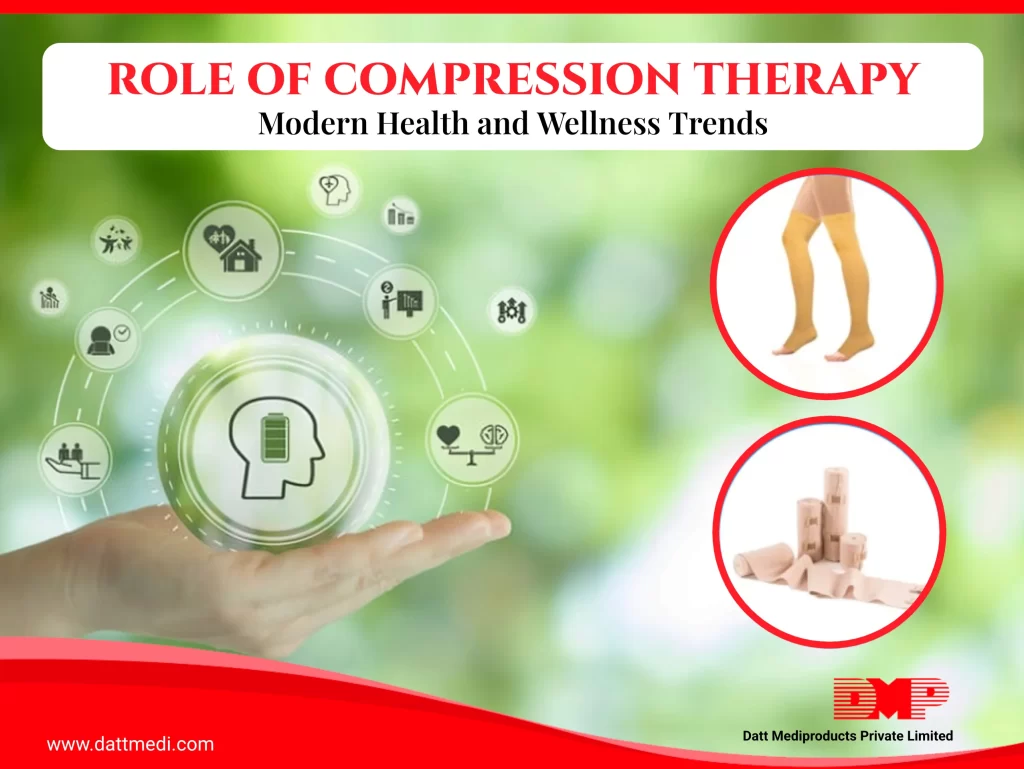
In today’s evolving wellness landscape, compression therapy has become a trusted and evidence-based practice. From elite athletes and healthcare professionals to individuals managing chronic conditions or sedentary lifestyles, compression products are now integral to modern self-care.
By improving circulation, reducing swelling, and supporting muscle health, compression therapy blends medical efficacy with everyday wellness—making it more accessible and beneficial than ever before.
1. Compression Therapy and Athletic Performance
Athletes across all disciplines are increasingly using compression therapy to improve outcomes on and off the field.
Improved Blood Flow:
Graduated compression supports venous return, helping muscles function more efficiently during strenuous activity.
Reduced Muscle Strain:
Aids in clearing metabolic waste like lactic acid, limiting inflammation and easing post-exercise soreness.
Enhanced Recovery Window:
Promotes faster readiness between training sessions by minimizing strain and supporting tissue repair.
Today, compression garments and wraps are a standard part of professional sports recovery protocols.
2. Compression Therapy in Injury Prevention and Healing
Whether after a sprain, strain, or surgery, compression therapy plays a vital role in musculoskeletal support.
- Controls Swelling (Edema): Facilitates lymphatic drainage from muscles & surrounding tissues, minimizing fluid build-up, inflammation and discomfort.
- Provides Stability: Delivers targeted pressure to support ligaments and muscles during healing.
- Boosts Oxygen Delivery: Improves nutrient supply and waste removal at the affected site, aiding tissue regeneration and reducing strain & fatigue.
This makes compression an essential component of post-surgical care, orthopedic treatment plans, and rehabilitation.
3. Daily Health and Wellness Benefits
Compression is not limited to sports or medical recovery—it supports everyday health and preventive care.
- Reduces Leg Tiredness:
Particularly helpful for professionals like nurses, teachers, and frequent travelers who spend long hours standing or sitting. - Manages Varicose Veins & Chronic Venous Insufficiency (CVI):
By applying gentle graduated pressure, compression stockings prevent blood from pooling in the veins, reducing discomfort, heaviness, and swelling in the legs. - Supports Circulation in Sedentary Lifestyles:
Maintains healthy blood flow in lower extremities during prolonged immobility, reducing the risk of complications linked to poor venous return.
Modern compression stockings and bandages provide discreet, all-day support for busy routines.
4. DMP’s Trusted Compression Solutions
At Datt Mediproducts, we deliver high-performance compression solutions tailored to diverse needs:
Velkomp® Compression Bandage:
- Adjustable pressure for injury management and swelling control
- Ideal for sports recovery, post-operative support, and general care
Velcare® Varicose Vein Stocking:
- Promotes circulation in the lower limbs
- Recommended for daily use by professionals and patients with venous disorders
👉 If you’re curious : Click Here to Explore our full range of compression products
5. Integrating Compression into Wellness Routines
Wellness goes beyond fitness—it’s about balance and consistency. Compression can be seamlessly included into everyday life:
- During or after workouts for improved performance and recovery
- At work or during travel to limit swelling and discomfort
- Alongside hydration, stretching, and nutrition to strengthen overall health outcomes
6. Backed by Science
Clinical evidence highlights that compression therapy:
- Enhances venous return and reduces pooling in extremities
- Supports healing in post-operative and trauma cases
- Improves endurance and physical comfort when used consistently
7. Comfort and Modern Design
Today’s compression products are designed with convenience in mind:
- Lightweight, breathable, and skin-friendly materials
- Easy to wear discreetly under clothing
- Simple to maintain for daily and long-term use
Far from the bulky models of the past, modern solutions combine medical effectiveness with everyday wearability.
8. The Future of Compression in Health & Wellness
Compression therapy is expanding beyond hospitals to become a lifestyle choice. Innovations on the horizon include:
- Smart wearables that adjust pressure in real time
- Sustainable fabrics and user-focused designs for improved comfort
Compression is no longer just a medical necessity—it’s a proactive wellness essential.
Whether you’re an athlete, recovering from an injury, or seeking to improve circulation during daily routines, compression therapy provides practical, science-backed support. At Datt Mediproducts, we are proud to offer innovative solutions that address the evolving needs of modern consumers.
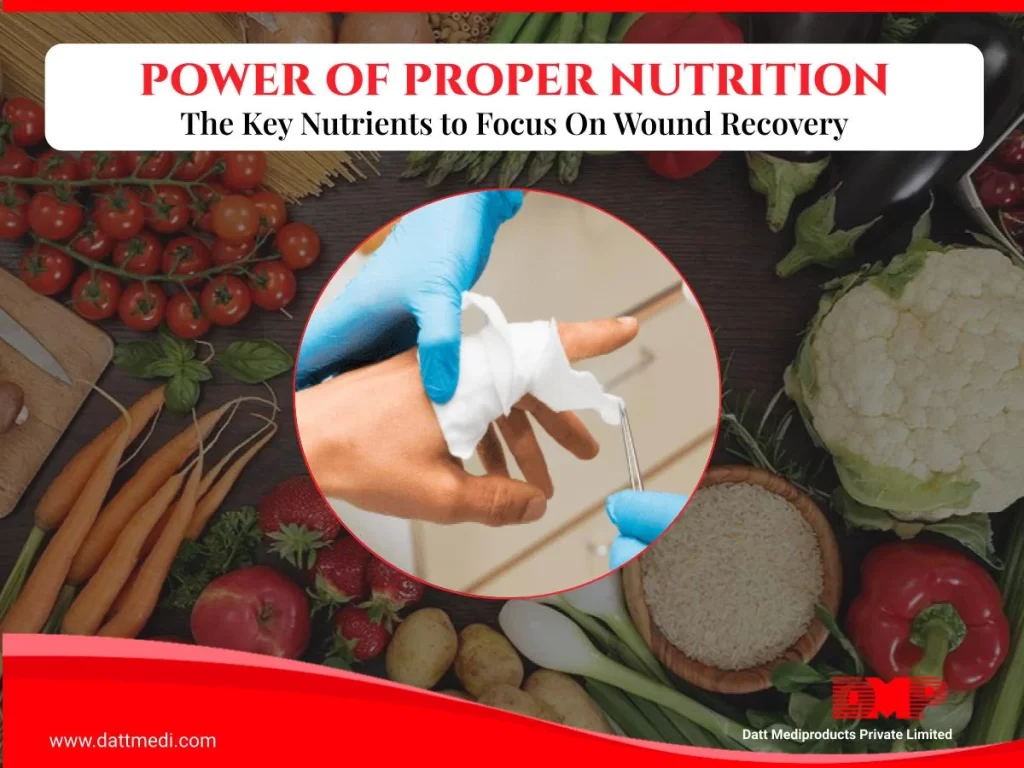
Wound healing is a complex biological process involving tissue repair, immune defense, and cellular regeneration. While medical treatment plays a key role, lifestyle choices significantly influence the body’s ability to heal.
From nutrition to stress management, everyday habits can either support faster recovery or hinder the healing process.
In this blog, we explore the key lifestyle factors that impact wound healing and how simple, evidence-based changes can make a difference.
1. Nutrition: Fuel for Tissue Repair
a. Protein
- Vital for collagen formation and wound matrix development
- Protein deficiency may lead to slower wound closure and increased risk of infection
b. Vitamins and Minerals
- Vitamin C: Enhances collagen synthesis and capillary strength
- Zinc: Supports immune function and cell proliferation
- Vitamin A: Promotes epithelialization and helps control inflammation
c. Hydration
- Maintains blood volume and supports oxygen/nutrient delivery
- Dehydration can delay granulation and cell regeneration
Tip: Include lean proteins, citrus fruits, leafy greens, and zinc-rich foods like seeds and legumes in your daily meals.
2. Smoking: A Major Healing Inhibitor
Nicotine and other chemicals in tobacco constrict blood vessels, reducing oxygen supply to healing tissue.
- Impairs collagen production and fibroblast function
- Increases the risk of infection and delayed healing
- Reduces overall immune response
Quitting smoking—even temporarily during recovery—can significantly improve healing outcomes.
3. Alcohol Consumption: Delaying Recovery
Excessive alcohol intake:
- Suppresses immune function
- Depletes nutrients like Vitamin C and zinc
- Prolongs inflammation and disrupts tissue repair phases
Limit alcohol consumption to promote a healthy inflammatory response and proper wound granulation.
4. Physical Activity and Mobility
Moderate movement encourages circulation and supports healing—especially for patients at risk of pressure ulcers.
- Improves oxygenation and nutrient transport
- Reduces risk of blood pooling and edema
- Prevents pressure injuries in bedridden individuals
Regular repositioning and guided physiotherapy are essential in wound care plans.
5. Stress Management: Healing Starts with the Mind
Chronic stress elevates cortisol levels, which suppresses immune function and delays inflammatory responses crucial for wound healing.
- Impairs macrophage activity and T-cell function
- Slows tissue repair and increases infection risk
Practices like mindfulness, deep breathing, and adequate rest can accelerate recovery.
6. Chronic Conditions & Lifestyle Adjustments
Certain medical conditions magnify wound healing challenges:
- Diabetes: High blood glucose impairs leukocyte function and circulation
- Obesity: Increased inflammation and reduced vascular flow to wound sites
Lifestyle interventions like glucose control, weight management, and routine exercise can reduce wound complications.
7. The Power of Sleep in Healing
During deep sleep, the body enters restorative phases that facilitate cell repair, hormone regulation, and immune modulation.
- Lack of sleep can delay fibroblast activation and collagen remodeling
- Poor sleep patterns are linked to chronic wound persistence
Aim for 7–9 hours of quality sleep to support recovery and immunity.
8. Wound Hygiene and Safe Practices
Proper wound care is essential for minimizing infection and supporting a moist healing environment.
- Clean wounds with prescribed solutions
- Avoid using unapproved topical agents or picking at scabs
- Use appropriate antimicrobial dressings and change them regularly
Always follow healthcare provider instructions for dressing techniques and frequency.
9. Lifestyle Checklist for Optimal Wound Healing
- Quit smoking or avoid exposure to tobacco
- Limit alcohol consumption
- Eat a balanced diet rich in healing nutrients
- Stay hydrated
- Engage in light physical activity or guided movement
- Practice stress-reduction techniques
- Get sufficient, restorative sleep
- Follow proper hygiene and wound dressing guidelines
Healing isn’t just about medicine—it’s about mindset, habits, and daily choices.
By aligning medical treatment with proactive lifestyle changes, patients can accelerate recovery, reduce complications, and regain their well-being faster.
At Datt Mediproducts, we believe in a holistic approach to healing. Our advanced wound care solutions, including antimicrobial dressings, are designed to support optimal recovery in synergy with healthy living.
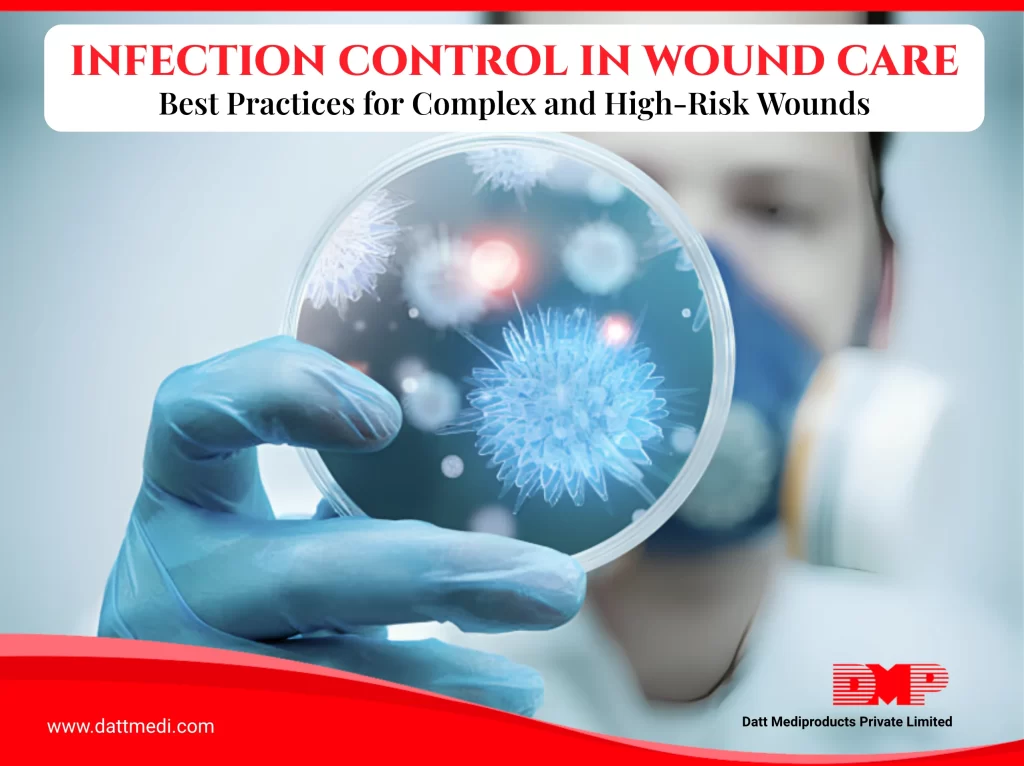
In wound care, infection prevention involves proactive measures to avoid contamination, while infection control refers to the steps taken after an infection has occurred—to contain its spread and reduce complications.
Understanding this distinction is vital, particularly when dealing with diabetic foot ulcers, surgical wounds, or chronic ulcers like those from varicose veins. These wounds, once infected, require more than just hygiene and topical care—they demand targeted intervention.
Why Infection Prevention is Critical in Wound Care
In high-risk patients (e.g., diabetics, post-operative individuals, or those with vascular issues), a wound infection can:
- Impair tissue regeneration can significantly slow down the body’s natural healing process.
- Trigger inflammation beyond the wound site
- Lead to sepsis or systemic failure
- Delay healing indefinitely without the right approach
Once bacteria attach to the wound surface and multiply, they secrete an Extracurricular Polymeric Substance (EPS) over the wound bed in the form of a patchy layer called BIOFILM. This biofilm is not only resistant to the host’s immune system but also to various basic antimicrobials. This is why even proper hygiene may not suffice creating a need for advanced infection control measures.
Common Signs of Infection Include:
- Increased redness or warmth
- Foul odor or purulent discharge
- Delayed granulation
- Pain out of proportion to wound size
- Systemic symptoms like fever or fatigue
The Role of Antimicrobial Dressing
Not all antimicrobial dressings work the same way. Selection should depend on the type of wound, degree of infection, and underlying comorbidities.
| Agent | Mechanism of Action | Ideal Use Cases |
| Nano-crystalline silver | Disrupts bacterial DNA and cell walls | Chronic wounds, surgical sites, burn care |
| Iodine | Broad-spectrum bactericidal effect | Infected diabetic foot ulcers, contaminated wounds |
| PHMB | Disrupts membrane integrity of microbes | Superficial infected wounds |
| Velvet | Kills microbes, hinders replication. Promotes angiogenesis & cell proliferation | Management of partial & full thickness wounds such as DFU, VLU, Necrotising Fasciitis, Burns or even other traumatic or surgical infected wounds |
Using the wrong dressing can delay healing or exacerbate infection. Selection must be guided by wound assessment, not just product availability.
Best Practices for Infection Prevention:
- Sterile Cleansing: Use prescribed solutions like saline, not harsh agents.
- Hygiene Compliance: Strict hand hygiene and PPE protocols for caregivers.
- Moisture Balance: Avoid dry wound beds or maceration.
Infection Control (Post-Infection Onset):
- Debridement if needed to remove necrotic tissue or biofilm
- Antimicrobial Dressings selected as per exudate level and infection type
- Systemic antibiotics for deep or spreading infections
- Regular monitoring to track changes in wound condition
Different Wounds Demand Different Protocols
- A clean surgical wound may require simple antimicrobial protection.
- A diabetic foot ulcer with infection may require systemic antibiotics, debridement, and layered dressing strategy.
- A venous ulcer may need antimicrobial compression therapy.
Avoid a one-size-fits-all approach—treatment must align with wound pathology.
Don’t overlook:
- Nutritional Support: Protein, Vitamin C, and Zinc for immune function and tissue repair
- Glycemic Control: Especially crucial in diabetic patients
- Patient Education: Empower caregivers with infection warning signs and dressing techniques
Wound care is both a science and a strategy. While infection prevention is essential, being prepared for infection control—with the right knowledge, products, and protocols—can make the difference between recovery and chronicity.
From nano-crystalline silver dressings to advanced wound care materials, our range is engineered for outcomes that matter. To Explore our full range of antimicrobial dressings: Click Here
